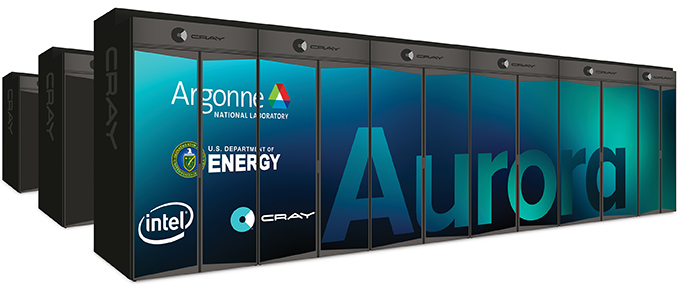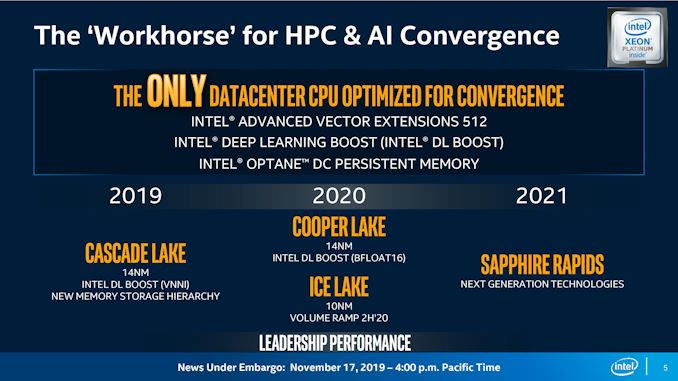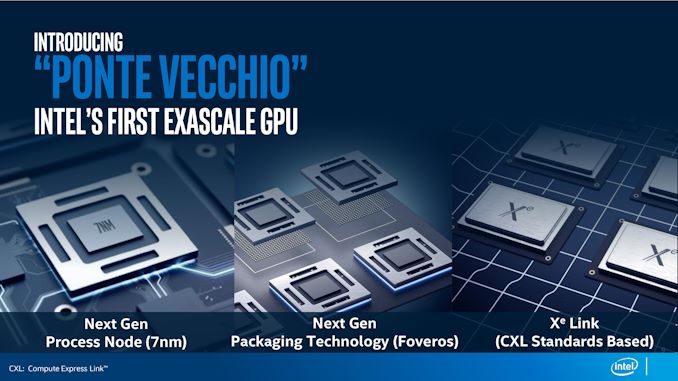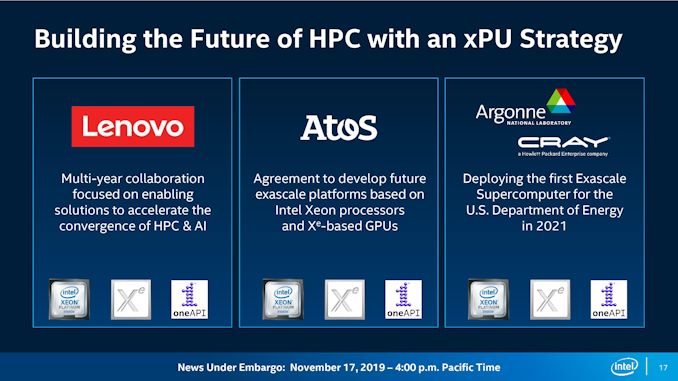Intel’s 2021 Exascale Vision in Aurora: Two Sapphire Rapids CPUs with Six Ponte Vecchio GPUs
by Dr. Ian Cutress on November 17, 2019 7:01 PM EST- Posted in
- CPUs
- Intel
- HPC
- Enterprise
- GPUs
- Aurora
- Exascale
- Xe
- Sapphire Rapids
- Ponte Vecchio

For the last few years, when discussing high performance computing, the word 'exascale' has gone hand-in-hand with the next generation of supercomputers. Even last month, on 10/18, HPC twitter was awash with mentions of ‘Exascale Day’, signifying 10^18 operations per second (that’s 10 million million million). The ‘Drive to Exascale’ is one of the key targets in the next decade for the supercomputing market, and Intel is going in with the Aurora Supercomputer ordered by the Argonne National Laboratory.
Intel has been working on the Aurora contract for a while now, and the project has changed scope over time due to market changes and hardware setbacks. Initially announced several years ago as a ‘deliver by 2020’ project between Argonne, Cray, and Intel, the hardware was set to be built around Intel’s Xeon Phi platform, providing high-throughput acceleration though Intel's AVX-512 instructions and the 10nm Knights Hill accelerator. This announcement was made before the recent revolution in AI acceleration, as well as Intel subsequently killing off the Xeon Phi platform after adding AVX-512 to its server processors (with the last breath Knights Mill receiving a very brief lifespan). Intel had to go back to the drawing board, and since Xeon Phi was scrapped, Intel’s audience has been questioning what it will bring to Aurora, and until today the company had only said that it would be built from a combination of Xeon CPUs and Xe GPUs.
An Aurora Node
As part of today’s announcement, Intel has put some information on the table for a typical ‘Aurora’ compute note. While not giving any specifics such as core counts or memory types, the company stated that a standard node will contain two next generation CPUs and six next generation GPUs, all connected via new connectivity standards.
Those CPUs will be Sapphire Rapids CPUs, Intel’s second generation of 10nm server processors coming after the Ice Lake Xeons. The announcement today reaffirmed that Sapphire Rapids is a 2021 processor; and likely a late 2021 processor, as the company also confirmed that Ice Lake will have its volume ramp through late 2020. Judging from Intel's images, Sapphire Rapids is set to have eight memory channels per processor, with enough I/O to connect to three GPUs. Within an Aurora node, two of these Sapphire Rapids CPUs will be paired together, and support the next generation of Intel Optane DC Persistent Memory (2nd Gen Optane DCPMM). We already know from other sources that Sapphire Rapids is likely to be DDR5 as well, although I don't believe Intel has said that outright at this point.
On the GPU side, all six of the GPUs per node will be Intel’s new 7nm Ponte Vecchio Xe GPU. As we covered in the Ponte Vecchio (PV) announcement, the basis of PV will be in small 7nm chiplets built on a microarchitecture variant of the Xe architecture. PV will employ a key number of Intel’s packaging technologies, such as Foveros (die stacking), Intel’s Embedded Multi-Die Interconnect Bridge (EMIB), and high bandwidth cache and memory. With regards to capabilities, Intel has only stated that PV will have a vector matrix unit and high double precision performance, which is likely going to be required for the research that Argonne performs.
The other core technology in an Aurora node is the use of the new Compute eXpress Link (CXL) standard. CXL will allow the CPUs and GPUs to connect directly together and work within a unified memory space. Intel stated in our briefings that the GPUs will be connected in an all-to-all topology, even though the imagery they provided doesn’t show that. In the diagram it shows every PV GPU connected to three others, with the top GPUs connected directly to the CPU. It is unclear if the CPUs talk to each other through CXL at this point, and what parts of the CXL standard Aurora will be using, however as CXL is based on the PCIe 5.0 physical standard, it will be interesting to see how (or if) Intel produces hardware for each interconnect standard.
Each Aurora node will have 8 fabric endpoints, giving plenty of topology connectivity options. And with the system being built in part by Cray, connecting the systems will be a version of their Slingshot networking architecture, which is also being used for the other early-2020s US supercomputers. Intel has stated that Slingshot will connect ~200 racks for Aurora, featuring a total of 10 petabytes of Memory and 230 petabytes of Storage.
Guessing Ponte Vecchio Performance
With this information, if we spitball some numbers on performance, here's what we end up with:
- Going with Intel's number of 200 racks
- Assume each rack is a standard 42U,
- Each Aurora node is a standard 2U,
- We know the system has 200 racks.
- Take out 6U per rack for networking and support,
- Take out 1/3 of the racks for storage and other systems
- We get a rounded value of 2400 total Aurora nodes (2394 based on assumptions).
This means we get just south of 5000 Sapphire Rapids CPUs and 15000 Ponte Vecchio GPUs for the whole of Aurora. Now when calculating the total performance of a supercomputer, the CPU and Accelerator performance often depends on the workload required. If Ponte Vecchio is truly an exascale class GPU, then let’s assume that the GPUs are where the compute is. If we divide 1 ExaFLOPs by 15000 units, we’re looking at 66.6 TeraFLOPs per GPU. Current GPUs will do in the region of 14 TF on FP32, so we could assume that Intel is looking at a ~5x increase in per-GPU performance by 2021/2022 for HPC. Of course, this says nothing about power consumption, and if we were to do the same math at 4U per node, then it would be ~7500 GPUs, and we would need 135 TF per GPU to reach exascale.
Delivering The Hardware
Despite initially being a ‘deliver by 2020’ project, Intel is now saying that Aurora will be delivered in 2021. This means that Intel has to execute on the following:
- Manufacturing at 10++ in sufficient yield with respect to cores/frequencies
- Manufacturing at 7nm for chiplets, both in yield and frequencies
- Transition through DDR3 to DDR4 (and DDR5?) in that time frame
- Transition through PCIe 3.0 to PCIe 4.0 and PCIe 5.0 in that time frame
- Release and detail its 2nd generation Optane DC Persistent Memory
- Provide an SDK to deal with all of the above
- Teach researchers to use it
On those last two points, Intel has stated that Ponte Vecchio and Aurora will be a primary beneficiary of the company’s new OneAPI SDK. This industry initiative, spearheaded by Intel, is designed to use a singular cross-architecture language called ‘Data Parallel C++’, based on C++ and SYCL, that can pull libraries designed to speak to various elements of Intel’s hardware chain. The idea is that software designs can write the code once, link appropriate libraries, and then cross-compile for different Intel hardware targets. In Intel’s parlance, this is the ‘xPU’ strategy, covering CPU, GPU, FPGA, and other accelerators. Aside from Argonne/Cray, Intel is citing Lenovo and Atos as key partners in the OneAPI strategy.
In order to achieve a single exascale machine, you need several things. First is hardware – the higher performance a single unit of hardware, the fewer you need and the less infrastructure you need. Second is infrastructure, and being able to support such a large machine. Third is the right problem that doesn’t fall afoul of Amdahl’s Law – something that is so embarrassingly parallel that can be spread across all the hardware in the system is a HPC scientist dream. Finally, you need money. Buckets of it.
In the past few years, the top supercomputers in the world have addressed all of these requirements by orders of magnitude: hardware is faster, infrastructure is readily available, traditionally serial problems are being re-architected to be parallel (or lower precision), and governments are spending more than ever for single supercomputers. A $5 million supercomputer used to get a research group into the top echelons of the Top 500 list. Now it’s more like $150+ million. The current leader, Summit, had an estimated build cost of $200 million. And Aurora will handily top that, with the deal valued at more than $500 million.
When I asked before the announcement if Argonne would be the first customer of Ponte Vecchio, the Intel executive heading the briefing dodged the question by instead answering his own, saying ‘we’re not disclosing other customers’. In all my time as a journalist, I don’t think I’ve ever had a question unanswered and dodged in such a way. Unfortunately I had no opportunity in the open Q&A session to follow up.
Ultimately, based on what we know so far, Intel still has a lot of work to do to deliver this by 2021. It may be the case that Aurora is that culmination of all its technologies, and that Intel would be prepared to use the opportunity to help smooth out any issues that might arise. At any rate, some of these technologies might not get in the hands of the rest of us until 2022.
Hopefully, when Aurora is up and running, we’ll get a chance to take a look. Watch this space.
Related Reading
- Intel's Interconnected Future: Combining Chiplets, EMIB, and Foveros
- Intel to Support Hardware Ray Tracing Acceleration on Data Center Xe GPUs
- Intel’s Xeon & Xe Compute Accelerators to Power Aurora Exascale Supercomputer
- Intel Details Manufacturing through 2023: 7nm, 7+, 7++, with Next Gen Packaging














43 Comments
View All Comments
visualzero - Monday, November 18, 2019 - link
Intel - Innovation by powerpoint. What a joke.Spunjji - Monday, November 18, 2019 - link
Jam tomorrow!mdriftmeyer - Monday, November 18, 2019 - link
That's all they got. Intel has hit a wall and all the innovation around them is passing them by.Duncan Macdonald - Monday, November 18, 2019 - link
Given the problems that Intel has had reaching 10nm - what is the chance that they will get 7nm working well enough for this project to come in on time? (Unless of course they contract TSMC to make the 7nm chips!!!)jabbadap - Monday, November 18, 2019 - link
Yeah those TFLOPS does not really compute. I must admit I don't know nothing about Supercomputers: But isn't Aurora use Cray Shasta cabinets? Only thing I could find about those is NERSC-9 supercomputer and if I'm not mistaken each of those can take 64 2Us or 32 4Us.Silma - Monday, November 18, 2019 - link
Intel's plans seem totally unrealistic.It was 5 years late for 10 nm but we must believe it'll produce in 7 nm in little less than a year?
Plus new interconnect plus new language, plus new packaging technology.
Also there's a reason why NVIDIA was so successfull in HPC: unlike Intel, it doesn't kill its technology (Xeon Phi),
What are supercomputers like Atos, which promised exascale Phi based machines, to do?
Their customers will surely be happy to know that the money they invested in next-gen was actually lost in no-gen.
haukionkannel - Monday, November 18, 2019 - link
Intel develop several generations at the same time. The 7nm have been under development Many years! So 7nm very soon is more than likely exspecially if their 10nm is so bad as it has been so far, They will drop it as soon as possible.mdriftmeyer - Monday, November 18, 2019 - link
My friends say otherwise and they should know seeing as their jobs revolve around it.Phynaz - Monday, November 18, 2019 - link
Good source.Dumbass.
Korguz - Monday, November 18, 2019 - link
Oh?? lets see you do better...oh wait.. you CAN'T